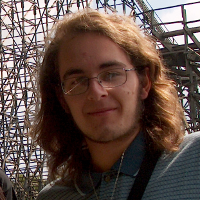I'm here in Koblenz working with the Arbeitsgruppe Aktives Sehen (AGAS)--the active vision team. In a word, I'm working with robots. Right now I'm involved with the Robbie 13 project, which is the 13th iteration (in as many semesters) of a robot that is by now quite adept at fulfilling its duties--namely, to autonomously navigate a simulated "disaster area", map the area, and find "victims" (heat sources). Robbie has been very successful at past competitions, participating in the RoboCup Rescue League. I won't go too far into detail, but there's a lot more information at the website if you're interested. Now, though, Robbie is being groomed to take part in a different competition, the SICK Robot Day. Unfortunately the description is all in German, but I'll summarize the basic competition. The robot will be placed in a large oblong arena with obstacles scattered about, and 9 signposts clearly labeled 1-9. The robot's task is to navigate to each of the signposts in order (naturally, it has to read the numbers itself), while avoiding the obstacles as well as a second robot doing the same task in the opposite order. A collision with the other robot will mean disqualification, but the final judge of success is speed. It sounds pretty challenging, but a lot of Robbie's existing capabilities are well-suited to this task. In fact, except for the lack of image recognition (to read the numbers) and weatherproofing (this competition will take place outside, rain or shine) he's almost got everything he needs right now. But of course there is always room for improvement, and we've got until September to make him ready.
Unfortunately I'll only be here until mid-August, so I won't get to see the little guy compete. Currently my task is to build a pan-tilt unit to integrate the new laser range finder. Robbie already has one of these, and it's an indispensable part of his operation--it scans a wide radius in 2 dimensions to sense walls, and it's hooked up to a little servo which allows it to scan up and down to get a 3-D snapshot, mostly for identifying inaccessible areas ("rough terrain"). It's just a little tiny one, though, and now we've got a big heavy-duty new one--the SICK S300. It's actually quite portable compared to most LRFs, but it still weighs more than a kilogram, so just sticking it on top of a servo won't quite work. That's what I'm here for. Although I've never done any CAD before, I jumped in feet-first and over the past week I made a pretty good, basic schematic for an aluminum bracket to hold the LRF. Once the servos get here, I can take a few final measurements, get the design finalize, and then find out if the thing works at all, but for now I'm working on the software to control the servos. It's been a long time since I've done any object-oriented programming, so once again I'm really learning on the job. Overall, though, I think I can get this all finished in just another week or so. I hope so, anyway--this is interesting work, but I'd like to get this finished and start on another project before I go. I'm particularly hoping to have a crack at the higher-level designing... actually contributing to the intelligence of the robot. Anyway, I'll keep you posted!




No comments:
Post a Comment